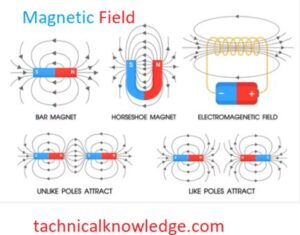
Describe a magnetic field
Magnetic forces can be seen in a magnetic field, an electric current, a changing electric field, or a vector field around a magnet. Magnetic compass needles and some other permanent magnets align in the direction of magnetic fields like the ones that exist on Earth. Electrically charged particles are forced to move in a circular or helical direction by magnetic fields. The functioning of electric motors is caused by this force, which is applied to electric currents in wires in a magnetic field. See magnetism for further information on magnetic fields.

The magnetic field is stationary and is referred to as a magnetostatics field when it surrounds a permanent magnet or a wire carrying a constant electric current in one direction. Its magnitude and direction are constant at any given site. The magnetic field is constantly changing in strength and direction around an alternating current or a fluctuating DC current.

Magnetic fields can be represented as lines of force or magnetic flux that leave north-seeking magnetic poles and enter south-seeking magnetic poles. The lines’ density indicates how strong the magnetic field is. The field lines are crowded or more thick, for example, at the poles of a magnet when the magnetic field is strong. Where the magnetic field is weaker and further away, they fan out and lose density. Parallel, straight lines that are evenly spaced apart depict a homogenous magnetic field.
The direction that a small magnet’s north-seeking pole points indicates the flux direction. The flux lines form closed loops and are continuous. They emerge from the north-seeking pole of a bar magnet, fan out and around, enter the magnet now at south-seeking pole, travel through the magnet to the north pole, and then emerge from the magnet once more. Webers are used as the magnetic flux SI unit. The total number of field lines that span a specific region is indicated by the number of webers.
Mathematically, magnetic fields may be represented by quantities called vectors, which have both direction and magnitude. The magnetic flux density, also known as magnetic induction, is represented by the vector B, while the magnetic field strength, also known as magnetic field intensity, is represented by the vector H. The magnetic field B may be viewed as the entire magnetic field, which also includes the contribution provided by the magnetic characteristics of the materials in the field.
The magnetic field H can be viewed as the magnetic field created by the passage of current through wires. The magnetizing field H is fairly modest when a wire is wrapped around a soft-iron cylinder, but the average magnetic field (B) may be thousands of times greater because B is substantially boosted by the alignment of the iron’s numerous small natural atomic magnets in the field’s direction. see magnetic permeability as well.
How is a magnetic field created?
Moving electric charges generate magnetic fields. A magnetic field may be produced when negatively charged electrons travel in specific ways. These fields can be produced in wires or in the atoms of magnetic materials (electromagnetism).

How can a magnetic field be measured?
A magnetic field’s strength and pointing direction are used to measure it.
Each magnetic field has some variations. There are magnetic fields that are big, strong, little, and weak in different combinations. The Earth’s magnetic field, for example, is strong but huge. In magnetism, physical proximity—how near or far it is—really matters. The magnetic field of a magnet will be larger the closer you are to it. The magnetic field of a magnet weakens as you go further away from it. (A magnetic field never stops; in theory, it extends to infinity, but it merely becomes less and less the further you are from it.
Let’s say you place a paperclip on a desk. If you held a magnet and stood on the other side of the room from the table, the paperclip would react to the magnetic field around the magnets, but the response would be very faint and might not be visible. The paperclip would, however, jump off the table and soar through the air to the magnet if you were to get closer, put the magnet on the table, and move it in that direction. Then, the magnetic field would be strong enough to beat gravity and friction, which had been stopping the paperclip from moving before. (This is a fantastic illustration of how magnetic forces may generate motion!)
What is a unit magnetic field and how to measure it?
Tesla units are used to express the magnetic flux density, which is a measure of a magnetic field’s intensity (International System of Measurement or SI measurement). Weber, Maxwell, Gauss, and even 109 gamma are just a few of the additional words and units used in the study of electromagnetics.
How can we “see” a magnetic field’s forces?
To demonstrate the direction of the forces at various points inside a magnetic field, we will sometimes draw field lines. At the magnet’s north pole, field lines leave the object, travel through the atmosphere, and then return through the south pole. Field lines don’t begin in one location and end in another; magnets move along “closed routes,” which means they follow the same path repeatedly.
Keep in mind that the magnetic field extends all the way around the magnet, not just along the lines we’ve drawn to represent the field but also in the spaces between the lines. The lines just assist in the visualization of the field’s direction at various points within and around the magnet.
Iron filings are an excellent tool for observing field lines within a magnetic field. Place a piece of paper over a bar magnet and place it on a table. Then scatter the filings across the paper and see how the lines form patterns that are compact at one magnet pole, more spread as they leave that pole, and compact once again at the opposite pole. The filings match the field lines of the bar magnet!

Leave a Reply